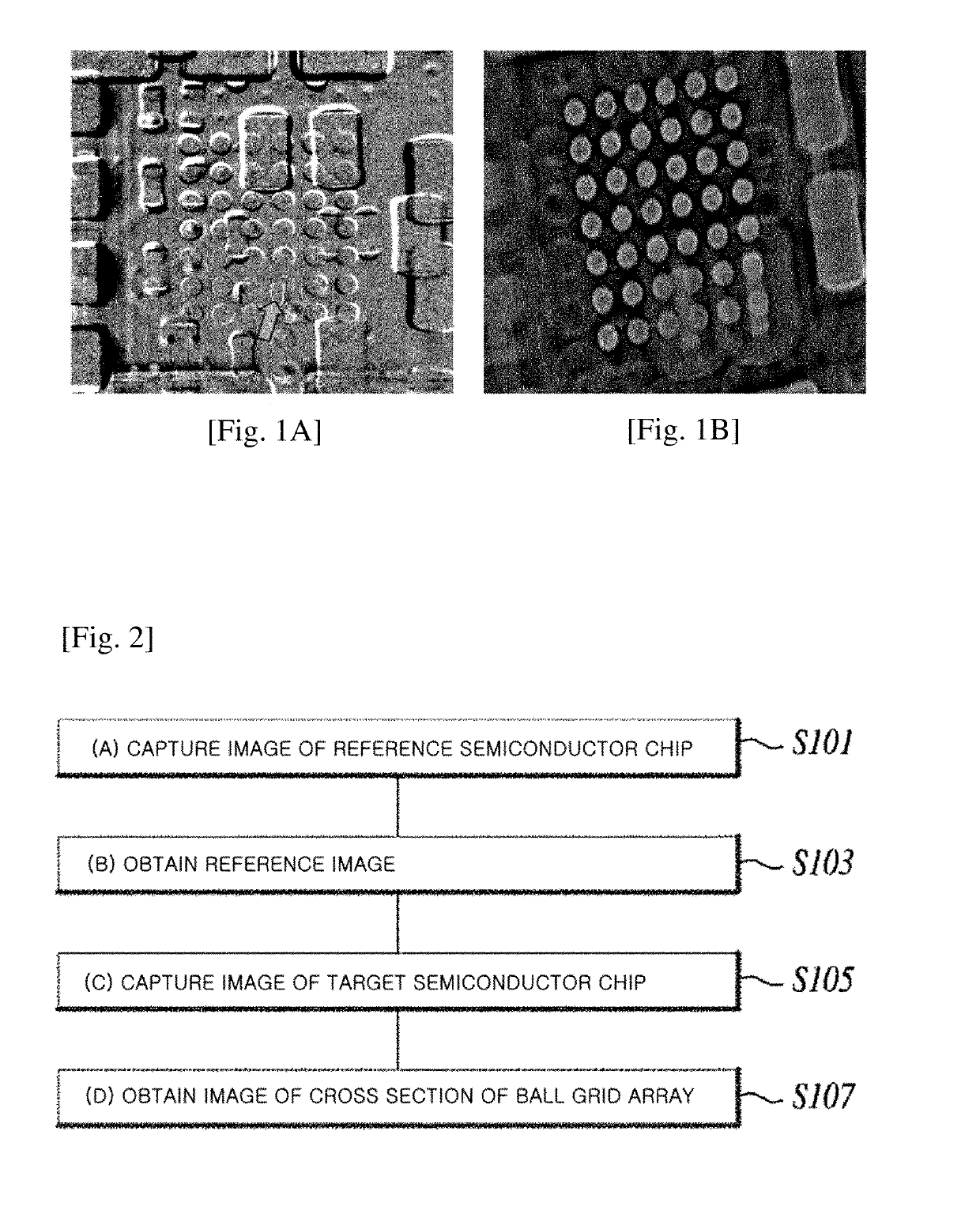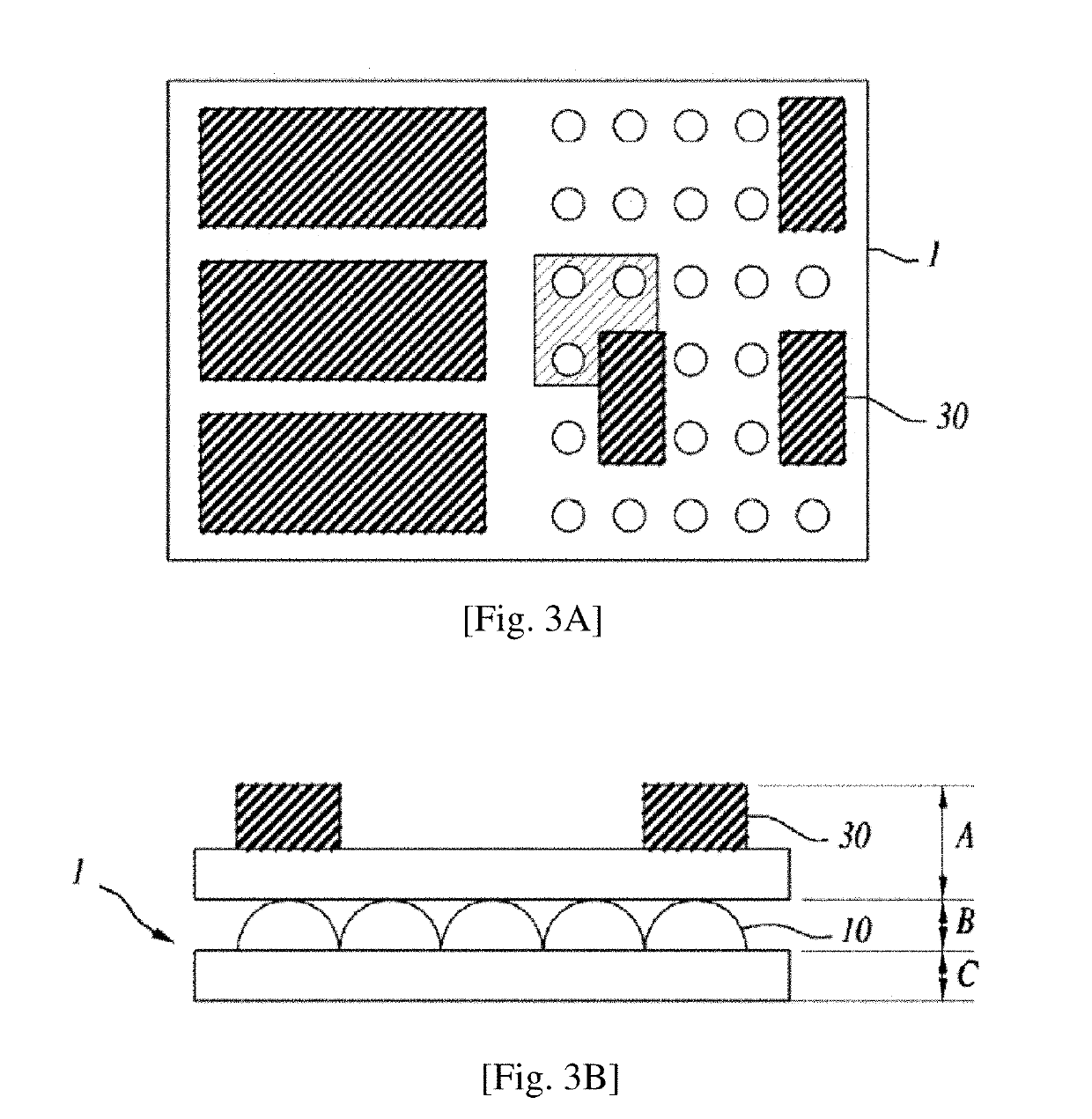Method for inspecting ball grid array-type semiconductor chip package
a technology of semiconductor chips and grid arrays, applied in the direction of material analysis using wave/particle radiation, instruments, image enhancement, etc., can solve the problems of complex solventing process, difficult to inspect bga-type semiconductor chips for defects, and short circuits, etc., to achieve accurate acquisition of the region of interest, improve inspection reliability, and rapid inspection
- Summary
- Abstract
- Description
- Claims
- Application Information
AI Technical Summary
Benefits of technology
Problems solved by technology
Method used
Image
Examples
first embodiment
[0049]FIG. 2 is a flowchart illustrating a method for inspecting a BGA-type semiconductor chip package according to the present invention.
[0050]Referring to FIG. 2, the method for inspecting a BGA-type semiconductor chip package may include the steps of (a) capturing an image of a reference semiconductor chip (S101), (b) obtaining a reference image (S103), (c) capturing an image of a target semiconductor chip (S105), and (d) obtaining an image of a cross section of a BGA (S107).
[0051]In the step (a) of S101, the 3D image of the reference semiconductor chip is obtained. The step (a) of S101 may be performed once or a plurality of times in an actual process so as to form a reference image.
[0052]In the step (a) of S101, the 3D image of any one reference semiconductor chip is captured using an X-ray computed tomography (CT). FIGS. 3A-3B are views illustrating a 3D image captured from a semiconductor chip 1 for obtaining a reference image in the method for inspecting from FIG. 2. FIG. 3A...
second embodiment
[0066]FIG. 6 is a flowchart illustrating a method for inspecting a BGA-type semiconductor chip package according to the present invention.
[0067]Referring to FIG. 6, the method for inspecting a BGA-type semiconductor chip package according to the second embodiment of the present invention may include the steps of (1) capturing a 3D image of a reference semiconductor chip (S201), (2) extracting an image of a BGA region (S203), (3) capturing a 2D image of the reference semiconductor chip (S205), (4) obtaining a reference image (S207), (5) capturing an image of a target semiconductor chip (S208), and (6) obtaining an image of a cross section of a BGA (S209).
[0068]In the step (1) of S201, the 3D image of the reference semiconductor chip may be obtained. In the step (1) of S201, the 3D image of any one reference semiconductor chip is captured using an X-ray CT. The step (1) of S201 corresponds to the above-described step (a) of S101, and an image of FIG. 3 may be obtained in the step (1) ...
third embodiment
[0077]FIG. 7 is a block diagram illustrating a configuration of an apparatus 100 for inspecting a semiconductor chip package according to the present invention. The apparatus 100 for inspecting a semiconductor chip package includes a first image acquisition unit 110, a second image acquisition unit 120, and an image processing unit 130.
[0078]The first image acquisition unit 110 uses a 3D image of a reference semiconductor chip to obtain a reference image in which a region of interest is removed from the 3D image.
[0079]The second image acquisition unit 120 obtains a 2D image of a target semiconductor chip.
[0080]The image processing unit 130 obtains an image of the region of interest from a difference between the reference image and the 2D image.
[0081]The reference semiconductor chip and the target semiconductor chip may include common regions of interest, such a region of interest may be preset, the image of the region of interest finally obtained by the image processing unit 130 may...
PUM
| Property | Measurement | Unit |
|---|---|---|
| specific angle | aaaaa | aaaaa |
| angle | aaaaa | aaaaa |
| nondestructive projection imaging technique | aaaaa | aaaaa |
Abstract
Description
Claims
Application Information
 Login to View More
Login to View More - R&D
- Intellectual Property
- Life Sciences
- Materials
- Tech Scout
- Unparalleled Data Quality
- Higher Quality Content
- 60% Fewer Hallucinations
Browse by: Latest US Patents, China's latest patents, Technical Efficacy Thesaurus, Application Domain, Technology Topic, Popular Technical Reports.
© 2025 PatSnap. All rights reserved.Legal|Privacy policy|Modern Slavery Act Transparency Statement|Sitemap|About US| Contact US: help@patsnap.com



